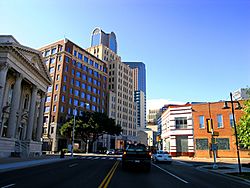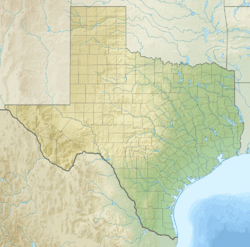First Presbyterian Church of Dallas facts for kids
Quick facts for kids First Presbyterian Church |
|
|---|---|

Harwood Historic District structures including the First Presbyterian Church (far left)
|
|
| 32°46′46″N 96°47′37″W / 32.77944°N 96.79361°W | |
| Location | 1835 Young St., Dallas, Texas |
| Country | United States |
| Denomination | Presbyterian Church (USA) |
| Architecture | |
| Architect(s) | C. D. Hill & Company |
| Style | Neoclassical Revival |
| Years built | 1912 |
The First Presbyterian Church of Dallas is a very old and important church in downtown Dallas, Texas, USA. It is located at 1835 Young Street. The church building is part of the Harwood Historic District and is a special Dallas Landmark.
This church was started in 1856. It was the first Presbyterian church of its kind in Dallas. Many other Presbyterian churches in the area grew from this original one.
Contents
History of the Church Building
The First Presbyterian Church of Dallas began on February 3, 1856. It was started by Reverend Robert Hamilton Byers. The church had only eleven members at first. They did not have their own building. So, they met in different places. These included private homes, a blacksmith shop, and even a printing shop.
Early Church Homes
In 1873, the church built its first own building. It was located at Elm and Ervay streets. Their second home was built in 1882. This was at Harwood and Main streets. It was the first brick church ever built in Dallas. By 1897, this building was made much bigger. It was changed so much that people thought of it as a new, third building. Its style was called Victorian eclectic.
The Current Building
The church's current building is its fourth home. It includes the main worship area and an educational building. These were built in 1911 and 1912. They officially opened on March 2, 1913. The church was designed by C. D. Hill & Company. This was a well-known architecture firm in Dallas. The building has a Greek Revival style. This means it looks like ancient Greek temples.
The large, fancy columns at the entrance are special. They are called Corinthian columns. They were the first of their kind in Dallas. Each column was so big that it needed its own train car to be brought from Indiana.
The outside walls of the church have beautiful "art glass" windows. These windows were made in 1912. The inside of the church is designed in a special way. It is called a modified Akron Plan. This plan helps people move easily between worship and Sunday School classes. It has a curved seating area that opens up to classrooms.
The current minister of the church is Rev. Amos J. Disasa.
Helping the Community
Since its very early days, First Presbyterian Church has helped people in Dallas. They have provided many important services.
- The church started a home for children. This home cared for orphaned and abandoned children. Today, a historical marker shows where this home began. It is now the Presbyterian Children's Home and Service Agency in Itasca, Texas.
- Children's Medical Center in Dallas started in 1921. It began as a small clinic for children. This clinic was in the basement of First Presbyterian Church. It was the first free clinic in the Southwest region.
- In 1975, the church began its Stewpot ministry. This program helps people who are homeless or in need. The Stewpot has become very famous. It is a model for other churches and cities. Since 2008, the Stewpot has served meals at The Bridge. This is a center in Dallas that helps homeless people. They serve three meals every day, seven days a week.
See also



